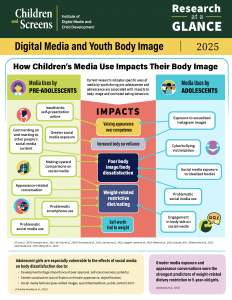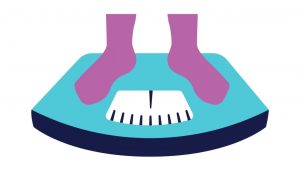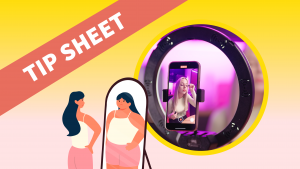Children and teens are growing up in a digital environment where images, filters, and online interactions shape how they see themselves.
 Research shows that social media use is closely linked to body dissatisfaction, restricted eating, and low self-esteem, especially during adolescence. Children and Screens’ Research-at-a-Glance on “Digital Media and Youth Body Image” distills the latest findings into clear takeaways for parents, educators, and policymakers.
Research shows that social media use is closely linked to body dissatisfaction, restricted eating, and low self-esteem, especially during adolescence. Children and Screens’ Research-at-a-Glance on “Digital Media and Youth Body Image” distills the latest findings into clear takeaways for parents, educators, and policymakers.
Did You Know?
-
- Harmful portrayals of body image online can affect children’s self-perception, emotions, and behavior.
- Social media use can be linked to both positive and negative outcomes – content and context determine the difference.
- Taking selfies and using filters can affect body satisfaction, from pre-adolescence to emerging adulthood.
- Different types of media use during either pre-adolescence or adolescence can lead to similar harmful impacts.
- There are proven interventions – from classroom media literacy to positive content strategies – that support body appreciation from early childhood through adolescence.
What You’ll Learn:
-
- Age-specific impacts: How pre-adolescents and adolescents differ.
- Selfies, filters, and avatars: What increases risk and what to watch out for.
- Content matters: Fitspiration vs. body positive media and why disclaimers often fall short.
- Interventions and protections: Evidence-backed practices that build resilience.
How You Can Use This:
-
- Guide family or classroom conversations about filters, comparisons, and online images.
- Equip pediatric primary care and mental health visits with evidence-based talking points.
- Inform parent workshops, school curricula, and professional trainings (i.e., teachers, clinicians, etc.).
What’s Inside the PDF:
-
- A concise, visual summary of current research
- Key takeaways at a glance
- Actionable interventions and protective strategies
Alberga, A.S., Withnell, S.J., & von Ranson, K.M. (2018). Fitspiration and thinspiration: A comparison across three social networking sites. Journal of Eating Disorders, 6. https://doi.org/10.1186/s40337-018-0227-x
Bell, B.T., Taylor, C., Paddock, D., & Bates, A. (2022). Digital Bodies: A controlled evaluation of a brief classroom-based intervention for reducing negative body image among adolescents in the digital age. British Journal of Educational Psychology, 92, 280-298. https://bpspsychub.onlinelibrary.wiley.com/doi/epdf/10.1111/bjep.12449
Choukas-Bradley, S., Roberts, S.R., Maheux, A.J., & Nesi, J. (2022). The perfect storm: A developmental-sociocultural framework for the role of social media in adolescent girls’ body image concerns and mental health. Clinical Child and Family Psychology Review, 25, 681-701. doi: 10.1007/s10567-022-00404-5
Chu, J., Ganson, K.T., Testa, Al-shoaibi, A., Jackson, D.B., Rodgers, R.F.,…& Nagata, J.M. (2024). Screen time, problematic screen use, and eating disorder symptoms among early adolescents: Findings from the Adolescent Brain Cognitive Development (ABCD) Study. Eat Weight Disord, 29. https://doi.org/10.1007/s40519-024-01685-1
Craddock, N., Garbett, K.M., Smith, H.G., Anquandah, J., White, P., & Williamson, H. (2025). “My body is amazing from the bottom to the top” – An RCT study testing two positive body image media micro-interventions for young children aged 4-6 years. Body Image, 52. https://doi.org/10.1016/j.bodyim.2025.101851
Curtis, R.G., Prichard, I., Gosse, G., Stankevicius, A., & Maher, C.A. (2023). Hashtag fitspiration: Credibility screening and content analysis of Instagram fitness accounts. BMC Public Health, 23. https://doi.org/10.1186/s12889-023-15232-7
Damiano, S.R., Paxton, S.J., Wertheim, E.H., McLean, S.A., & Gregg, K.J. (2015). Dietary restraint of 5-year-old girls: Associations with internalization of the thin ideal and maternal, media, and peer influences. International Journal of Eating Disorders, 48, 1166-1169. https://doi.org/10.1002/eat.22432
De Coen, J., Goossens, L., Bosmans, G., Debra, G., Verbeken, S. (2024). Body dissatisfaction and disordered eating symptoms in children’s daily life: Can parents protect against appearance comparison on social media? Body Image, 48. https://doi.org/10.1016/j.bodyim.2023.101647
De Valle, M. K., Gallego-García, M., Williamson, P., & Wade, T. D. (2021). Social media, body image, and the question of causation: Meta-analyses of experimental and longitudinal evidence. Body Image, 39, 276-292. https://doi.org/10.1016/j.bodyim.2021.10.001
Digennaro, S., & Iannaccone, A. (2025). Imagining another self: The use of social media among preadolescents and its body-related consequences. An exploratory study. SAGE Open. 1-18. https://doi.org/10.1177/21582440251321364
Dijkslag, I.R., Santos, L.B., Irene, G., & Ketelaar, P. (2024). To beautify or uglify! The effects of augmented reality face filters on body satisfaction moderated by self-esteem and self-identification. Computers in Human Behavior, 159. https://doi.org/10.1016/j.chb.2024.108343
Ferdousi, J.S., Bradley, G.L., & Carlini, J. (2023). Through thick and thin: Exposure to Instagram advertisements and willingness to engage in appearance-altering practices. The Journal of Psychology, 157, 367-388. https://doi.org/10.1080/00223980.2023.2221014
Fioravanti, G., Benucci, S., Ceragioli, G., & Casale, S. (2022). How the exposure to beauty ideals on social networking sites influences body image: A systematic review of experimental studies. Adolescent Research Review, 7, 419-458. https://doi.org/10.1007/s40894-022-00179-4
Garcia, B.P., Garcia, M.F., Olszewska, A., Yilmaz, L., Ibañez, C., Blanes, M.,…& Maldonado, J. (2019). Is this my own body? Changing the perceptual and affective body image experience among college students using a new virtual reality embodiment-based technique. Journal of Clinical Medicine, 8. https://doi.org/10.3390/jcm8070925
Harriger, J.A., Serier, K.N., Luedke, M., Robertson, S., & Bojorquez, A. (2018). Appearance-related themes in children’s animated movies released between 2004 and 2016: A content analysis. Body Image, 26, 78-82. https://www.sciencedirect.com/science/article/abs/pii/S1740144518300081
Jarman, H.K., Fuller-Tyszkiewicz, M., McLean, S.A., Rodgers, R.F., Slater, A, Gordon, C.S. & Paxton, S.J. (2023). Who’s most at risk of poor body image? Identifying subgroups of adolescent social media users over the course of a year. Computers in Human Behavior, 147, 1-10. https://doi.org/10.1016/j.chb.2023.107823
Leggett-James, M.P., & Laursen, B. (2022). The consequences of social media use across the transition into adolescence: Body image and physical activity. Journal of Early Adolescence, 1-8. doi: 10.1177/02724316221136043
Maes, C., & Lenne, O. (2022). Filters and Fillers: Adolescents’ filter use on social media and the acceptance of cosmetic surgery. Journal of Children and Media, 16, 587-605. https://doi.org/10.1080/17482798.2022.2079696
Meeus, A., Everaert, G., Eggermont, S., & Beullens, K. (2023). Filtering the I from the ideal: Examining preadolescents’ online self-presentation in relation to their perceived attractiveness. Social Media + Society. 1-10. https://doi.org/10.1177/20563051231205598
Paquette, M.M., Böthe, B., Dion, J., Girouard, A., & Bergeron, S. (2023). Can I love my body even if it doesn’t look like the porn stars? Longitudinal associations between pornography use frequency and body appreciation in a diverse sample of adolescents. Archives of Sexual Behavior, 52, 3471-3489. doi: 10.1007/s10508-023-02679-3
Paraskeva, N., Haywood, S., Hasan, F., Nicholls, D., Toledano, M.B., & Diedrichs, P.C. (2024). An exploration of having social media influencers deliver a first-line digital intervention to improve body image among adolescent girls: A qualitative study. Body Image, 51. https://doi.org/10.1016/j.bodyim.2024.101753
Park, J., & Kim, H.Y. (2025). Avatars as coping mechanisms for body image inadequacy: A snapshot of generation Z consumers in the metaverse. Clothing and Textiles Research Journal. https://doi.org/10.1177/0887302X251324578
Riccio, P., Colin, J., Ogolla, S., & Oliver, N. (2024). Mirror, mirror on the wall, who is the whitest of all? Racial biases in social media beauty filters. Social Media + Society, 10. https://doi.org/10.1177/20563051241239295
Salazar, L.R. (2017). Cyberbullying victimization as a predictor of cyberbullying perpetration, body image dissatisfaction, healthy eating, dieting behaviors, and life satisfaction. Journal of Interpersonal Violence, 36. https://doi.org/10.1177/088626051772
Skowronski, M., Busching, R., & Krahé, B. (2021). Links between exposure to sexualized Instagram images and body image concerns in girls and boys. Journal of Media Psychology, 34. https://doi.org/10.1027/1864-1105/a000296
Steinsbekk, S., Wichstrøm, Stenseng, F., Nesi, J., Hygen, B., & Skalická, V. (2021). The impact of social media use on appearance self-esteem from childhood to adolescence – A 3-wave community study. Computers in Human Behavior, 114. https://doi.org/10.1016/j.chb.2020.106528
Tiggemann, M., & Zaccardo, M. (2018). ‘Strong is the new skinny’: A content analysis of #fitspiration images on Instagram. Journal of Health Psychology, 23, 1003-1011. doi: 10.1177/1359105316639436
Trekels, J. (2024). From filters to body positivity: Opposing social media messages and adolescent body image. Psychology of Popular Media, 14, 432-439. https://doi.org/10.1037/ppm0000565
Vandenbosch, L., Fardouly, J., & Tiggemann, M. (2022). Social media and body image: Recent trends and future directions. Current Opinion in Psychology, 45. https://doi.org/10.1016/j.copsyc.2021.12.002
Wang, Y., Wang, J., Geng, J., Wang, H., & Lei, L. (2023). Body talk on social networking sites and restrained eating among adolescents: A test of a multiple mediation model. Body Image, 45, 145-152. https://www.sciencedirect.com/science/article/abs/pii/S1740144523000347




